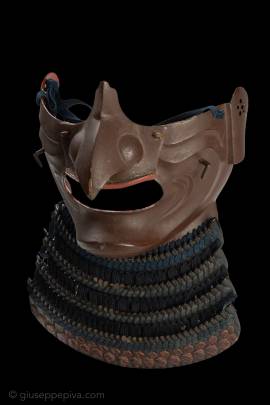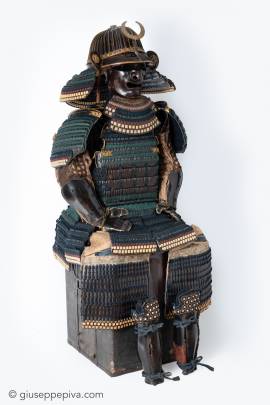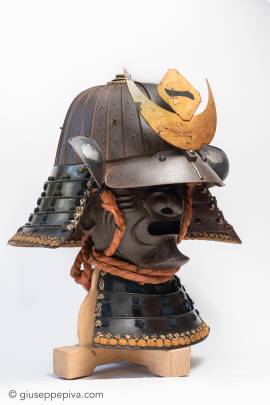Samurai mask shaped as a TenguMid Edo period (1615-1867)This menpō presents some features, such as the nose shaped like a beak, which suggests that represents the face of a Tengu. The Tengu are mythological creatures of ancient Japanese tradition identify both as kami (gods) and as yokai (demons). They are usually represented as birdman with a long prominent nose or, as in this case, a beak. The mask interior is lacquered and the iron yodarekake is made in four kiritsukezane plates.On this page is a comprehensive glossary of common...
WORKS FOR SALE
Complete samurai armorEarly Edo Period, 17th century Kabuto [helmet]: 32-plate so-fukurin kabuto. The shikoro (neck guard) is all in hon-kozane (true scale), divided in three sections.Menpō [mask]: A rare lacquered iron ressei-men (mask with fierce expression) with a large nose and no mustache.Dō [cuirass]: Maru-dō (made in a single piece) with hon-kozane (true scale) construction. The lacing is in two different style, with a difference in the central part (munakoshitori); gilt-brass rims and fine pierced kanamono (application).Sode [shoulder guards]: Mid-size type (chu-sode), with a cut...
Signed by Myōchin Muneaki and dated 1853Signature: Kaei 6 - Ushidoshi Oshu Nihonmatsu-ju Myōchin Ki (no) Muneaki sakuMade in 1853 by Myōchin Ki Muneaki in Nihonmatsu castle. The helmet is a 24-plate suji kabuto with five rows of visible rivets. The shape is rather tall (koseizan), and the fittings, such as the visor (mabezashi) and the maedate holder (haraidate), are beautifully crafted. The five-plate shikoro bears on the fukigaeshi a rare kamon (family crest) made of silver maki-e lacquer, depicting the butterfly (hachō) used by the Taira clan in the ancient times and later taken up by...
Copyright © 2016 - giuseppe piva - VAT: 05104180962










